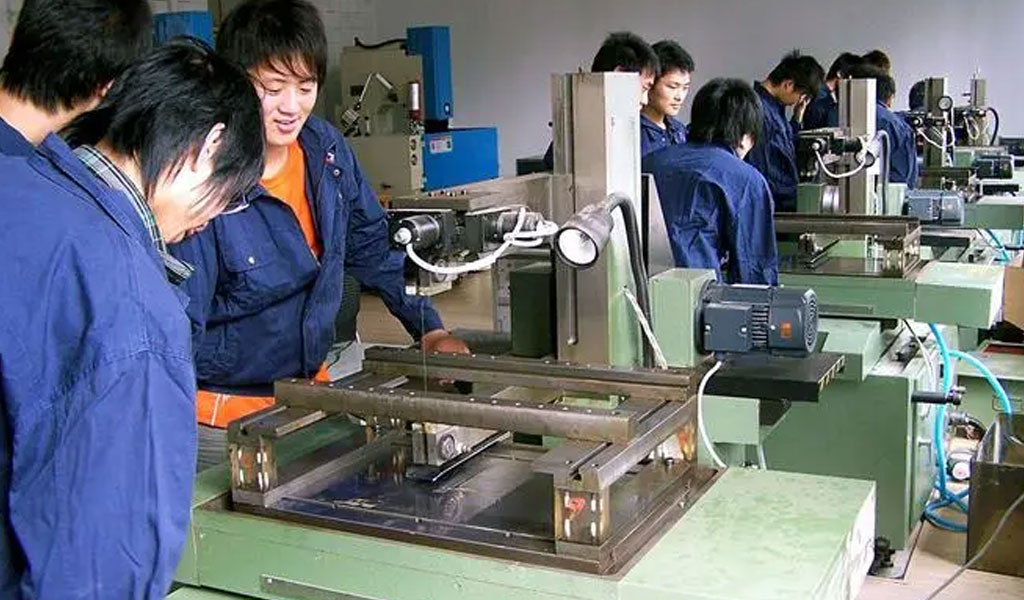The machinery manufacturing industry is very broad in scope, including the manufacture of various machines such as transportation tools, machine tools, agricultural machinery, textile machinery, power machinery and precision instruments, generally casting, forging, heat treatment, machining, assembly and painting, etc. The occupational disease hazards are very significant.
Machining is the use of various machine tools for metal parts such as turning, planing, drilling, grinding, milling and other cold processing; the general production process of machining produces relatively small occupational hazards, mainly the impact of emulsions and cutting oils used in metal cutting on workers, due to the high-speed rotation of machine tools, emulsions splashed around, easy to contaminate the skin, can cause folliculitis and acne, etc.. In the rough grinding and fine grinding process can also produce a large amount of dust.
- Production dust: mainly exists with the foundry industry, in the process of sand preparation, modelling, sand fall, sand cleaning, etc., can produce a high concentration of dust, especially when the sandblasting process to dress the castings, the dust concentration is very high, the quartz used is more dangerous, can cause silicosis and casters pneumoconiosis. In the machining process, the grinding and polishing of metal parts can produce metallic and mineral dust, causing millers’ pneumoconiosis. When welding, welding flux, welding rod core and the material being welded, evaporate at high temperatures to produce a large amount of welding dust and harmful gases, long-term inhalation of higher concentrations of welding dust can cause welders’ pneumoconiosis.
- High temperature, heat radiation: mainly in the casting, forging and heat treatment work, foundry furnace, drying furnace, molten metal, hot castings, forging and heat treatment workshop heating furnace and red hot metal parts are generated by strong heat radiation, the formation of high temperature environment. Heat stroke occurs in severe cases.
- Harmful gases: melting furnace and heating furnace can produce carbon monoxide and carbon dioxide, the concentration at the filling mouth is often higher; with phenolic resin and other binders produce formaldehyde and ammonia; heat treatment can produce organic solvent vapour; electroplating can produce chromic acid mist, nickel acid mist, sulphuric acid mist and cyanide cyanide; welding can produce carbon monoxide and nitrogen oxides; spray paint can produce benzene, toluene, xylene, etc.; all can cause Occupational poisoning.
- Noise, vibration and ultraviolet light and ionising radiation: in the process of machinery manufacturing, the use of sand pounding machines, wind tools, various forging hammers, grinding wheels, rivets, etc., can produce strong noise, vibration; electric welding, gas welding, sub-arc welding and plasma welding ultraviolet light, such as improper protection can cause electro-optical ophthalmia. In the process of flaw detection of workpieces, often using X-rays and radioactive sources to detect flaw, if not take the correct protection can lead to radiation damage.
- Heavy physical labour and trauma, burns in the poorly mechanised enterprises, casting, sand, manual forging are heavy physical labour, even if the use of air hammers or water presses, due to the need to change the position and direction of the workpiece, physical labour is very intense, while working at high temperatures, easy to cause changes in body temperature regulation and cardiovascular system.
Casting and forging have a high rate of trauma and burns, mostly due to splashes of iron, steel, iron filings and slag; machining workshops have more eye and finger trauma. In addition the coolant used in the process of metal cutting in machining also has a certain impact on the workers’ skin.
